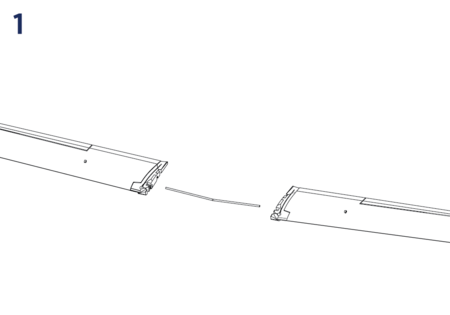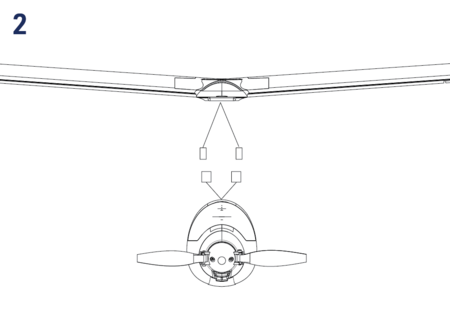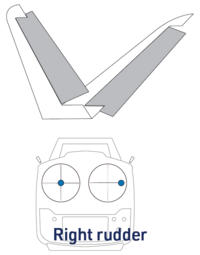KAVAN Falke 1800mm ARF - Instruction manual
Introduction
Congratulations on your purchase of the FALKE 1800mm high-performance motor-powered glider. You are about to start the assembly of a model manufactured from virtually unbreakable EPO (expanded polyolefin) foam, powered by a mighty brushless motor and lightweight LiPo battery. Everybody who has already mastered flying a "full house" trainer - with aileron, elevator, rudder, and throttle control - will enjoy this beautiful high-performance thermal glider.
Before you start
- If you are not an experienced RC pilot, plan to have a fully competent pilot check your completed model and help you with your first flights. Even though we have tried to provide you with a thorough instruction manual, RC models are rather complicated and an experienced modeller can quickly check over your model to make sure your first flights are successful.
- Please assemble your model exactly according to these instructions. Do not attempt to modify or change your model in any way, as doing so may adversely change its flying characteristics.
- Before you begin, please check the entire contents of this kit to make sure that no parts are missing or damaged. This will also help you to become familiar with each component of your plane. If you find that any of the parts are either missing or damaged, please contact your dealer immediately for replacement.
- Trial fit each part before glueing it in place. Make sure you are using the correct part and that it fits well before assembling. No amount of glue can make up for a poorly-fitting part.
- The manual contains a drawing showing the default position of the Centre of Gravity (CG) and recommended control surface throws. Please note it is essential to keep the recommended CG position for the first flight otherwise the model could be unstable, hard to control or even unable to fly at all! Later, you can fine-tune the CG position to suit your flying style and skills.
Precautions
This RC model is not a toy. Use it with care and strictly following the instructions in this manual.
Assemble this model following strictly these instructions. DO NOT modify or alter the model. Failure to do so, the warranty will lapse automatically. Follow the instructions to obtain a safe and solid model at the end of the assembly.
Children under the age of 14 must operate the model under the supervision of an adult.
Assure that the model is in perfect condition before every flight, taking care that all the equipment works correctly and that the model is undamaged in its structure.
Fly only on days with a light breeze and in a safe place away from any obstacles.
Safety precautions and warnings
- An RC aeroplane is not a toy! If misused, it can cause serious bodily harm and damage to property. Fly only in a safe place and follow all instructions and recommendations in this manual. Beware of the propeller! Keep loose items that can get entangled in the propeller away from the spinning propeller, including loose clothing, or other objects such as pencils and screwdrivers. Ensure that your and other people's hands and face are kept away from the rotating propeller.
- As the user of this product, you are solely responsible for operating it in a manner that does not endanger yourself and others or result in damage to the product or the property of others. This model is controlled by a radio signal that is subject to interference from many sources outside your control. This interference can cause momentary loss of control, so it is advisable to always keep a safe distance in all directions around your model, as this margin will help to avoid collisions or injury.
- Never operate your model with low transmitter batteries.
- Always operate your model in an open area away from power lines, cars, traffic or people. Avoid operating your model in populated areas where injury or damage can occur.
- Carefully follow the directions and warnings for this and any optional support equipment (chargers, rechargeable batteries, etc.) which you use.
- Keep all chemicals, small parts and anything electrical out of the reach of children.
- Moisture causes damage to electronics. Avoid water exposure to all equipment not specifically designed and protected for this purpose.
- The model is mostly made of plastics – it is not fireproof. It may not be exposed to higher temperatures, otherwise severe distortion of the foam airframe or other damage may occur.
Specification
| Wingspan | 1800 mm |
| Length | 1150 mm |
| Wing area | 27 dm² |
| All-up weight | 660–710 g |
| Motor | C2714-1450 |
| ESC | KAVAN R–20B BEC |
| Propeller | 7×6" |
Set contents
• Almost ready-to-fly model of a sailplane with the brushless motor, speed controller and servos installed, instruction manual.
You will also need
- At least 4-channel RC set featuring V-tail mix, 11.1 V 1200–1600 mAh LiPo flight pack.
- Regular modeller’s tools - modeller’s knife, screwdrivers, 1.5 and 2 mm Allen key, pliers etc.
Model assembly
- Locate the steel wire wing joiner (note the "V" shape ensuring the correct wing dihedral) and slide both wing halves onto the joiner. (Fig. 1)
- Connect the aileron servo cables to the corresponding extension cables in the wing opening in the fuselage. (Fig. 2)Note: The kit is supplied with a Y-cable for ailerons so you can use even the most basic 4-channel radios to control your FALKE 1800. If you intend to use independent control of aileron servos and an advanced computer radio, you will have to replace the default Y-cable with two 25–30 cm extension cables.
- Attach the plastic wing joiner and secure the wing to the fuselage with two M5×20 mm nylon bolts. (Fig. 3)
- Attach the V-tail planes to the tailplane seat and secure them with the plastic joiner and M3 hex screw to the fuselage. (Fig. 4)
- Connect the plastic quick links to the ruddervator horns. (Fig. 5)
- The flight pack is to be placed in the bay in the centre of the cockpit; use a Hook-and-loop tie to fasten it. You can place your receiver (secured with a strip of Hook-and-loop or double-sided foam tape) behind the flight pack. Connect servos and your ESC to the receiver; deploy the antennas so their active parts are square to each other (if you are using a receiver featuring diversity antennas). With your radio on, set the servos to the neutral position (sticks and trims centred) - screw in or out the quick links as needed. Perform the throttle range calibration of the ESC as described in the attachment of this manual. (Fig. 6)
- Attach the canopy.
RC set installation and preflight check
- Referring to the instruction manual of your radio carefully hook up the onboard electronics.
- Once everything has been correctly connected, turn on your transmitter and plug in the flight pack. Check the neutral positions and throws of all control surfaces - double-check the correct set-up of the V-tail mix. If you need to make the control surface throws smaller, simply move the pushrod closer to the centre on the servo arm or move it far from the control surface on the control horn. And vice versa.
| Low rate | High rate | |
| Ailerons | 10 mm up/5 mm down 1 | 13 mm up/ 7 mm down |
| Ailerons (Airbrake) | 10 mm up | 10 mm up |
| Elevator | ± 7 mm | ± 10 mm |
| Elevator (Airbrake) | 2 mm up | 2 mm up |
| Rudder | ± 10 mm | ± 13 mm |
- The "Low rate" recommended control surface throws are suitable for a less skilled pilot and regular soaring. The "High rate" setting allows an experienced pilot to explore the full capabilities of his model. The aileron differential (aileron down deflection reduced to 50 % of up deflection) is only possible with a computer radio.
- Check the direction of rotation of the propeller. If it was incorrect, simply swap two of the three wires between the ESC and motor or program the ESC (refer to the ESC manual).
- Check the correct position of the centre of gravity (CG) – 56–63 mm behind the leading edge of the wing (Fig. 7). Adjust the CG position by moving the flight pack - if you could not reach the recommended position, do not hesitate to add an appropriate amount of lead to the nose or tail. An extra couple of grams won’t spoil the flying characteristics - but the incorrect CG position is a killer.
- Fully charge your flight pack and transmitter batteries, check the proper function of your radio and perform the range check of your radio according to its instruction manual. The range has to be almost the same with the motor off and at full throttle (no more than a 10 % decrease is acceptable). DO NOT try to fly unless the range check is 100 % successful.
Flying
The test flying and fine-tuning is pretty much straightforward, there will be no surprise for a medium-advanced pilot that is supposed to fly this model.
Recycling and waste disposal note (European Union)

Electrical equipment marked with the crossed-out waste bin symbol must not be discarded in the domestic waste; it should be disposed of via the appropriate specialised disposal system. In the countries of the EU (European Union) electrical devices must not be discarded via the normal domestic waste system (WEEE - Waste of Electrical and Electronic Equipment, Directive 2012/19/EU). You can take your unwanted equipment to your nearest public collection point or recycling centre, where it will be disposed of in the proper manner at no charge to you. By disposing of your old equipment in a responsible manner you make an important contribution to the safeguarding of the environment!
EU declaration of conformity (European Union)

Hereby, KAVAN Europe s.r.o. declares that the model FALKE and the included electronic and electric devices are in compliance with the requirements of relevant European directives and harmonized norms. The full text of the Declaration of Conformity is available at www.kavanrc.com/doc/.
Guarantee
The KAVAN Europe s.r.o. products are covered by a guarantee that fulfils the currently valid legal requirements in your country. If you wish to make a claim under guarantee, please contact the retailer from whom you first purchased the equipment. The guarantee does not cover faults which were caused in the following ways: crashes, improper use, incorrect connection, reversed polarity, maintenance work carried out late, incorrectly or not at all, or by unauthorised personnel, use of other than genuine KAVAN Europe s.r.o. accessories, modifications or repairs which were not carried out by KAVAN Europe s.r.o. or an authorised KAVAN Europe s.r.o., accidental or deliberate damage, defects caused by normal wear and tear, operation outside the Specification, or in conjunction with equipment made by other manufacturers. Please be sure to read the appropriate information sheets in the product documentation!












